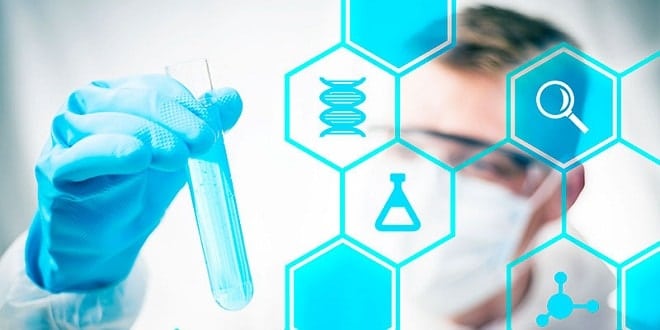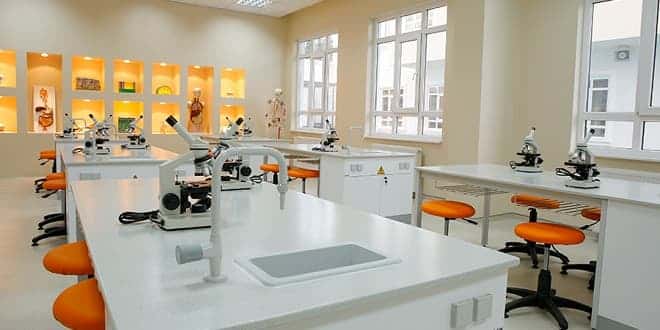Chemical Equilibrium
Equilibrium is a state in which there are no observable changes as time goes by.
Chemical equilibrium is achieved when:
1.) the rates of the forward and reverse reactions are equal and
2.) the concentrations of the reactants and products remain constant
-
Equilibrium
-
There are two types of equilibrium: Physical and Chemical.
–Physical Equilibrium
-
H20 (l) ↔ H20 (g)
–Chemical Equilibrium
-
N2O4 (g) ↔ 2NO2
-
Physical Equilibrium
-
Chemical Equilibrium
-
Chemical Equilibrium
-
Law of Mass Action
-
Law of Mass Action- For a reversible reaction at equilibrium and constant temperature, a certain ratio of reactant and product concentrations has a constant value (K).
-
The Equilibrium Constant (K)- A number equal to the ratio of the equilibrium concentrations of products to the equilibrium concentrations of reactants each raised to the power of its stoichiometric coefficient.
-
Law of Mass Action
-
For the general reaction:
-
Equilibrium Constant
N2O4 (g) ↔ 2NO2 (g)
-
Chemical Equilibrium
-
Chemical equilibrium is defined by K.
-
The magnitude of K will tell us if the equilibrium reaction favors the reactants or the products.
-
If K » 1……..favors products
-
If K « 1……..favors reactants
-
Equilibrium Constant Expressions
-
Equilibrium constants can be expressed using Kc or Kp.
-
Kc uses the concentration of reactants and products to calculate the eq. constant.
-
Kp uses the pressure of the gaseous reactants and products to calculate the eq. constant.
-
Equilibrium Constant Expressions
-
Equilibrium Constant Equations
-
Homogeneous Equilibrium
-
Homogeneous Equilibrium- applies to reactions in which all reacting species are in the same phase.
N2O4 (g) ↔ 2NO2 (g)
-
Equilibrium Constant Expressions
-
Relationship between Kc and Kp
-
Equilibrium Constant Calculations
The equilibrium concentrations for the reaction between carbon monoxide and molecular chlorine to form COCl2 (g) at 740C are [CO] = 0.012 M, [Cl2] = 0.054 M, and [COCl2] = 0.14 M. Calculate the equilibrium constants Kc and Kp.
-
Equilibrium Constant Calculations
-
The equilibrium constant Kp for the reaction is 158 at 1000K. What is the equilibrium pressure of O2 if the PNO = 0.400 atm and PNO = 0.270 atm?
-
Heterogeneous Equilibrium
-
Heterogeneous Equilibrium- results from a reversible reaction involving reactants and products that are in different phases.
-
Can include liquids, gases and solids as either reactants or products.
-
Equilibrium expression is the same as that for a homogeneous equilibrium.
-
Omit pure liquids and solids from the equilibrium constant expressions.
-
Heterogeneous Equilibrium Constant
-
Heterogeneous Equilibrium Constant
-
Equilibrium Constant Calculations
Consider the following equilibrium at 295 K:
The partial pressure of each gas is 0.265 atm. Calculate Kp and Kc for the reaction.
-
Multiple Equilibria
-
Multiple Equilibria- Product molecules of one equilibrium constant are involved in a second equilibrium process.
-
What does the Equilibrium Constant tell us?
-
We can:
–Predict the direction in which a reaction mixture will proceed to reach equilibrium
–Calculate the concentration of reactants and products once equilibrium has been reached
-
Predicting the Direction of a Reaction
-
The Kc for hydrogen iodide in the following equation is 53.4 at 430ºC. Suppose we add 0.243 mol H2, 0.146 mol I2 and 1.98 mol HI to a 1.00L container at 430ºC. Will there be a net reaction to form more H2 and I2 or HI?
H2 (g) + I2 (g) → 2HI (g)
-
Reaction Quotient
The reaction quotient (Qc) is calculated by substituting the initial concentrations of the reactants and products into the equilibrium constant (Kc) expression.
IF
-
Qc > Kc system proceeds from right to left to reach equilibrium
-
Qc = Kc the system is at equilibrium
-
Qc < Kc system proceeds from left to right to reach equilibrium
-
Reaction Quotient
-
Calculating Equilibrium Concentrations
-
If we know the equilibrium constant for a reaction and the initial concentrations, we can calculate the reactant concentrations at equilibrium.
-
ICE method
Reactants Products
Initial (M):
Change (M):
Equilibrium (M):
-
Calculating Equilibrium Concentrations
-
At 1280ºC the equilibrium constant (Kc) for the reaction is 1.1 x 10-3. If the initial concentrations are [Br2] = 0.063 M and [Br] = 0.012 M, calculate the concentrations of these species at equilibrium.
-
Calculating Equilibrium Concentrations
-
Express the equilibrium concentrations of all species in terms of the initial concentrations and a single unknown x, which represents the change in concentration.
-
Write the equilibrium constant expression in terms of the equilibrium concentrations. Knowing the value of the equilibrium constant, solve for x.
-
Having solved for x, calculate the equilibrium concentrations of all species.
-
Factors that Affect Chemical Equilibrium
-
Chemical Equilibrium represents a balance between forward and reverse reactions.
-
Changes in the following will alter the direction of a reaction:
–Concentration
–Pressure
–Volume
–Temperature
-
Le Châtlier’s Principle
-
Le Châtlier’s Principle- if an external stress is applied to a system at equilibrium, the system adjusts in such a way that the stress is partially offset as the system reaches a new equilibrium position.
-
Stress???
-
Changes in Concentration
-
Increase in concentration of reactants causes the equilibrium to shift to the ________.
-
Increase in concentration of products causes the equilibrium to shift to the ________.
-
Changes in Concentration
Change Shift in Equilibrium
Increase in [Products] left
Decrease in [Products] right
Increase in [Reactants] right
Decrease in [Reactants] left
-
Changes in Concentration
FeSCN2+(aq) ↔ Fe3+(aq) + SCN-(aq)
a.) Solution at equilibrium
b.) Increase in SCN-(aq)
c.) Increase in Fe3+(aq)
d.) Increase in FeSCN2+(aq)
-
Changes in Volume and Pressure
-
Changes in pressure primarily only concern gases.
-
Concentration of gases are greatly affected by pressure changes and volume changes according to the ideal gas law.
PV = nRT
P = (n/V)RT
-
Changes in Pressure and Volume
Change Shift in Equilibrium
Increase in Pressure Side with fewest moles
Decrease in Pressure Side with most moles
Increase in Volume Side with most moles
Decrease in Volume Side with fewest moles
-
Changes in Pressure and Volume
-
Changes in Temperature
-
Equilibrium position vs. Equilibrium constant
-
A temperature increase favors an endothermic reaction and a temperature decrease favors and exothermic reaction.
Change Endo. Rx Exo. Rx
Increase T K decreases K increases
Decrease T K increases K decreases
-
Changes in Temperature
Consider: N2O4(g) ↔ 2NO2(g)
The forward reaction absorbs heat; endothermic
heat + N2O4(g) ↔ 2NO2(g)
So the reverse reaction releases heat; exothermic
2NO2(g) ↔ N2O4(g) + heat
Changes in temperature??
-
Effect of a catalyst
-
How would the presence of a catalyst affect the equilibrium position of a reaction?
…




